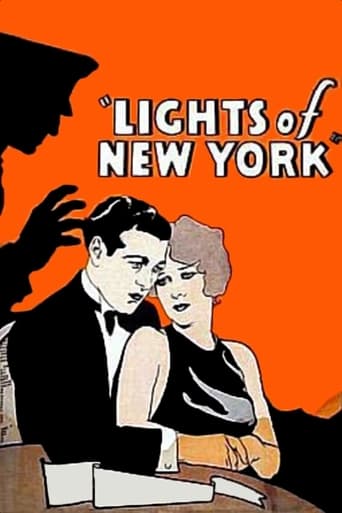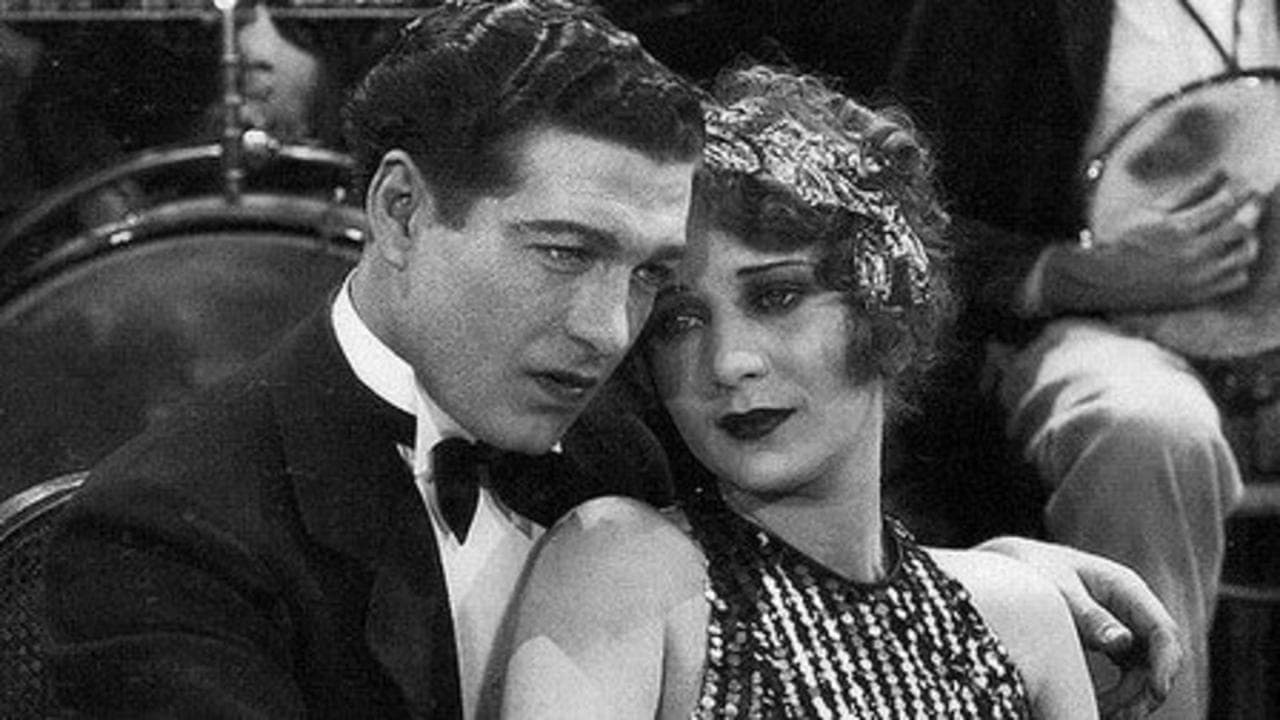kidboots
"Lights of New York" originally started out as an experimental two reel Vitaphone short that eventually snowballed into the first all talkie feature film. Helene Costelle was supposedly one of the most beautiful actresses in Hollywood and sister to (in my opinion the real beauty) Dolores Costello, who seemed to get all the breaks. Poor Helene is best known for appearing in this pretty dreary film that bought a revolution to Hollywood!!Two bootleggers on the lam in "Main Street" convince a couple of small town barbers to try their luck on Broadway. The barbers Eddie (Cullen Landis) and Gene (Eugene Palette) don't realise that their barber shop is soon a cover for illegal bootlegging activities. They soon do realise it and regret the day they left their small town. The only thing keeping them going is the loan that Eddie's mother gave them and that they desperately want to pay back. Eddie becomes re-acquainted with Kitty Lewis (Helene Costello) a girl from his home town who has made good on Broadway. Kitty is worried about "Hawk" Miller (Wheeler Oakman) who is always hanging around her but Eddie, innocently, thinks she is exaggerating as "Hawk" already has a girlfriend Molly (Gladys Brockwell) but to reassure her he gives her a little handgun to frighten unwanted admirers away. "Hawk", who has killed a police officer and has the "Feds" closing in, decides to frame Eddie. Meanwhile Molly is getting pretty fed up with "Hawks" treatment of her and after a showdown where he tells her he is after a chicken and not an old hen the stage is set for - Murder!!!The fact is it isn't completely awful, apart from gangsters and showgirls alike speaking in their best elocution voices and that was still happening in films in 1930. Gladys Brockwell (if a trifle melodramatic) and Eugene Palette (quite natural) were okay and were the most seasoned actors in the cast. There was no John or Ethel Barrymore to be seen - Cullen Landis and Helene Costello soon returned to the obscurity from which they had come. I also didn't notice much of the "hidden mike" - where people had to be grouped around different objects ie a telephone or sitting on a couch before they could engage in conversation. People who saw it at the cinema probably started to think that all policeman talked in that flat monotone as that trend continued in many early talkies ie "Little Caesar" (1930). In any case they were probably intrigued by the novelty of a completely all talkie - with some singing and dancing - film in 1928.Recommended.
lugonian
When someone asks the question, "What was the first talking picture?" the answer that immediately comes to mind is THE JAZZ SINGER (1927) starring Al Jolson. Well, that's partially correct. For anyone who's never seen THE JAZZ SINGER might expect an all-sound motion picture with songs. In retrospect, THE JAZZ SINGER does include songs, but much of the scenario was silent accompanied by a Vitaphone orchestral score. With other major studios experimenting the methods of silent films by adding talking sequences to its existing underscoring and inter-titles, LIGHTS OF NEW YORK (Warner Brothers, 1928), directed by Bryan Foy, scripted by Murray Roth and Hugh Herbert, was a step in the right direction for being the first all-talking feature length movie. As with many Hollywood firsts, LIGHTS OF NEW YORK was and still is not a great film due to awkward acting and offbeat dialogue, yet the result is another landmark during the dawn of sound made essential to the history of motion pictures.Opening with a prologue, the first inter-title reads: "This is a story of Main Street and Broadway - a story that might have been torn out of last night's newspaper. Main Street - 45 minutes from Broadway - but a thousand miles away." Because his girlfriend, Kitty Lewis, has gone to New York and made a success for herself, Eddie Morgan (Cullen Landis), a barber yearning for a better life outside his small own where nothing ever happens, asks his mother (Mary Carr), proprietor of the Morgan Hotel, for a $5,000 loan so that he and his friend, Gene (Eugene Palette) can go into partnership with Jake Jackson (Walter Percival) and Dan Dickson (Jere Delaney), guests in Room 21. At first Mrs. Morgan relents loaning the money until she meets with these "gentlemen" before heading back to New York the following morning. Story: "Broadway - 45 minutes from Main Street, but a million miles away." Six months pass. Eddie and Gene, owners of the White Way Barber Shop on 46th Street, come to realize their big mistake for being talked into having their barbershop as a front for bootleggers. Unknown to Eddie, "Hawk" Miller (Wheeler Oakman), owner of the Night Hawk Club ("where anything can happen and usually does") is not only the ring leader of the bootleg operation, but out to get his Kitty, dancer at his club, for himself, much to the jealous nature of Molly Thompson (Gladys Brockwell), his rejected mistress. As Miller plots to do away with Eddie by placing the boxes of Old Century liquor in his barbershop, Miller is later shot and killed by a mysterious assassin, leaving poor Eddie as the prime suspect.A straightforward melodrama with an amusing bit reminiscent of a vaudeville routine where a drunk approaches a cop (Eddie Kane) on Broadway asking where the other side of the street is. For a motion picture that began as a two-reel Vitaphone short, LIGHTS OF NEW YORK, with its backstage musical sounding title, is basically an underworld melodrama with gangster types speaking in gangster lingo. The most memorable line comes from Wheeler Oakman giving an order to his boys, Sam and Tommy (Tom Dugan and Guy D'Ennery) about Eddie, to "Take him ... for ... a ride." This particular scene is the one usually clipped into documentaries of motion pictures, especially when the subject matter is about early talkies. The film is also historical in a sense in offering a inside glimpse of 1920s night clubs better known then as "speakeasies," consisting of chorus girls, dancing patrons and one vocalization of "At Dawning" by the master of ceremonies (Harry Downing). With no "major star" names in the cast, the only one of some familiarity is Eugene Palette, whose distinctive gravel voice made recognizable during his long range of character parts lasting through the late 1940s. His one crucial scene finds him trying to hide the fact from a couple of detectives (Robert Elliott and Tom McGuire) that the customer sitting in his barber chair with his face covered with a towel happens to be a recently murdered Hawk Miller. Aside from Palette and Tom Dugan, other members of the cast, namely silent screen veterans Cullen Landis and Helene Costello, have virtually drifted to obscurity shortly after this film's release. Gladys Brockwell as the girl "who's loved and lost," gives a type of performance of a middle-aged Joan Crawford from the 1960s. Sadly Brockwell passed away the following year (1929) from complications sustained in an automobile accident. For being 1928 production, LIGHTS OF NEW YORK has an advance appeal of one made in the 1940s, not by Warners but something out of a Monogram Pictures programmer. Visual effects with shadows of bootleggers committing their crimes at night simply has that 1940s film noir feel to it. Often labeled as a very bad picture by historians, this remains a real curio as it did way back when, as well as a great opportunity hearing the voices of actors of the silent screen.Never distributed on video cassette, LIGHTS OF NEW YORK can be found occasionally on Turner Classic Movies where it's been playing since May 13, 1995. So the next time someone asks, "What was the first talking picture?" chances are the reply may still be THE JAZZ SINGER, but the final answer remains THE LIGHTS OF NEW YORK. As far as silent films are concerned, there's no turning back now. (**)
drednm
LIGHTS OF NEW YORK was the first "all-taking" feature film, coming in at a brisk 57 minutes and directed by Bryan Foy (of the famous vaudeville family).The story has two dopey barbers (Cullen Landis, Eugene Palette) yearning for a chance at "big city life" and getting involved with gangsters and bootleg booze. One of the guys gets framed for the murder of a cop but is saved at the last minute by a gun moll (Gladys Brockwell).Much of the story takes place in a night club called The Night Hawk, which is run by a crook named Hawk (Wheeler Oakman) who has his eye on a pretty chorine (Helene Costello) who is the girl friend of Landis. Costello gets to do a brief dance, and we hear Harry Downing (made up to resemble Ted Lewis) sing "At Dawning) in his best Al Jolson style.The acting ranges from good (Palette and Brockwell) to awful (Oakman). A couple of the actors muff their lines but then keep right on with the scene. As noted elsewhere this was intended to be a short 2-reeler and was made on a shoestring budget. Yet the sound quality is surprisingly good, the voices all register clearly, and there is a neat cinematic touch in the silhouette death.The film was a box-office smash even though it was shown as a silent film where theaters were not wired for the new sound technology. No one expected this little film to gross an amazing $1.3 million. It briefly made stars of Costello and Landis and certainly launched Palette on his long career as a star character actor.Co-stars include Mary Carr as the mother, Robert Elliott as the detective, Eddie Kane as the street cop, and Tom Dugan as a thug.
tom.hamilton
Fascinating and amusingly bad, Lights of New York is the first all talkie feature and one that almost never saw the light of day.
Two naive barbers (Eddie and Gene) from out of town get involved with bootleggers and end up fronting a speak. When a cop is shot by one of the bootleggers the police start to close in, and the Hawk (who shot the officer) decides to pin the murder on Eddie instructing his henchman to "take him for a ride". But it's the Hawk himself who takes the bullet in a twist that will surprise few.Shot in one week at a cost of $23,000, "Lights" was originally meant as a two reeler but Foy took advantage of Jack Warner's absence to extend it to six. When Warner discovered this he ordered Foy to cut it back to the original short. Only when an independent exhibitor offered $25k for the film, did Warners actually look at the film, which went on to make a staggering $1.3 million.Seen now this is an extremely hokey piece, with acting that ranges from the passable (Eugene Pallette) to trance like (Eddie's Granny in a particularly risible scene) and much of the playing is at the level of vaudeville. Since it's an early talkie (4 part-talkies preceded it) that's about all the characters do, and very slowly at that. The script feels improvised, visual style is non existent (apart from the shooting scene done in silhouette) and scenes grind on interminably. Title cards are intercut which redundantly announce characters and locales.Despite all this "Lights" is a compelling experience, as we watch actors and crew struggling with the alien technology, and changing cinema for ever.Catch it if you can


 AD
AD



